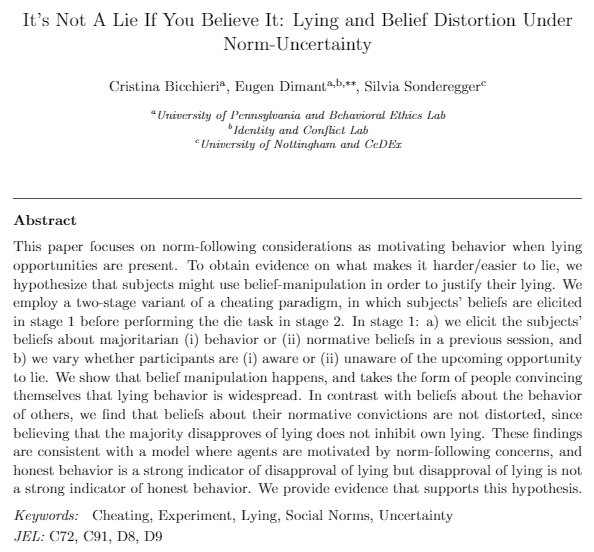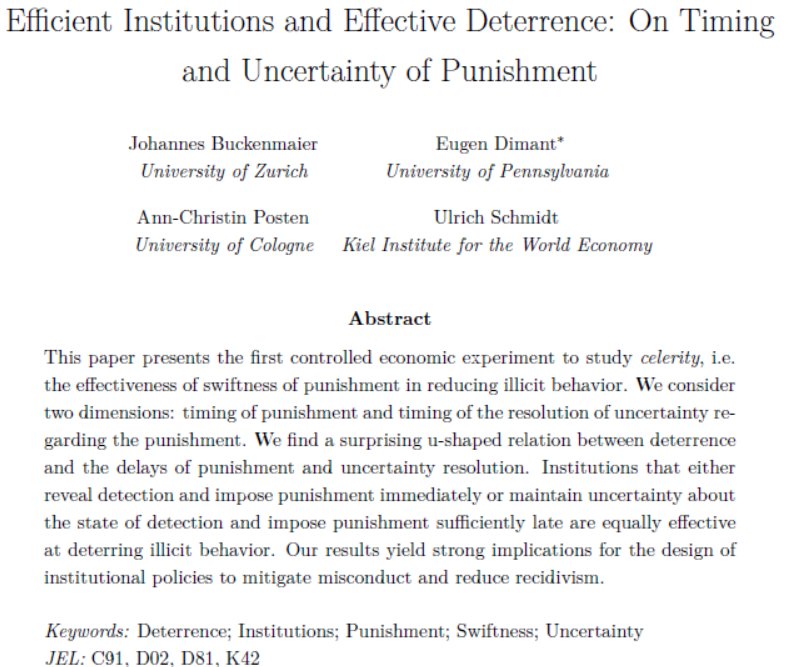
💡New paper (with the fantastic @BellaRen19 & @ME_Schweitzer @Wharton) examining the role of social motives in spreading misinformation/conspiracy theories.
Paper: tinyurl.com/4mch6mk9
Short🧵with results
#EconTwitter @DG_Rand @Sander_vdLinden @GordPennycook @jayvanbavel
1/n
Paper: tinyurl.com/4mch6mk9
Short🧵with results
#EconTwitter @DG_Rand @Sander_vdLinden @GordPennycook @jayvanbavel
1/n
https://twitter.com/ME_Schweitzer/status/1435595177293332483

2/N
Great research analyzing the dissimination of misinformation & what to do about it has been produced by @DG_Rand @Sander_vdLinden @GordPennycook @jayvanbavel... et al. (& their teams)
They show how pervasive misinfo spread is & how people reason at the individual level.
Great research analyzing the dissimination of misinformation & what to do about it has been produced by @DG_Rand @Sander_vdLinden @GordPennycook @jayvanbavel... et al. (& their teams)
They show how pervasive misinfo spread is & how people reason at the individual level.
3/N
Here, we are interested in the *collective* dimension of misinfo spread. We focus on social motives (e.g., feeling of belongingness, norms etc.) as a motivating mechanism to spread conspiracy theories (CT).
Understanding these social dynamics is important. And challenging.
Here, we are interested in the *collective* dimension of misinfo spread. We focus on social motives (e.g., feeling of belongingness, norms etc.) as a motivating mechanism to spread conspiracy theories (CT).
Understanding these social dynamics is important. And challenging.
4/N
We consider the possibility that people share CTs that they know to be untrue to advance ulterior motives, such as to build social ties.
We introduce a novel framework & show that social motives can overwhelm accuracy motives➡️people to share what they know to be false
We consider the possibility that people share CTs that they know to be untrue to advance ulterior motives, such as to build social ties.
We introduce a novel framework & show that social motives can overwhelm accuracy motives➡️people to share what they know to be false
5/N
Across 3 preregistered studies (total N=1,560 Prolific workers), we investigate the social motives for sharing conspiracy theories.
Study 1 finds that people are willing to trade off accuracy to build social connections when sharing CTs. So it's not inattentiveness alone.
Across 3 preregistered studies (total N=1,560 Prolific workers), we investigate the social motives for sharing conspiracy theories.
Study 1 finds that people are willing to trade off accuracy to build social connections when sharing CTs. So it's not inattentiveness alone.
6/N
In Study 2, participants were either incentivized to be accurate or received social rewards (likes/comments from others)
Finding: people anticipated that sharing CTs generates higher social approval than real news but also knew what's real and what's fake when incentivized.
In Study 2, participants were either incentivized to be accurate or received social rewards (likes/comments from others)
Finding: people anticipated that sharing CTs generates higher social approval than real news but also knew what's real and what's fake when incentivized.

7/N
In Study 3, we show how social reinforcement influences CT sharing behavior.
We developed an interactive platform that mimics Twitter. Participants could share real news / CTs & were either rewarded for the former or the latter with likes & approval (no monetary incentives)
In Study 3, we show how social reinforcement influences CT sharing behavior.
We developed an interactive platform that mimics Twitter. Participants could share real news / CTs & were either rewarded for the former or the latter with likes & approval (no monetary incentives)
8/8
We find that social reinforcement for CT sharing indeed amplifies CT sharing; not the case for true news sharing.
Note: though participants in different conditions shared CTs at different rates, across conditions, no more than 10% participants believed that CTs were true.
We find that social reinforcement for CT sharing indeed amplifies CT sharing; not the case for true news sharing.
Note: though participants in different conditions shared CTs at different rates, across conditions, no more than 10% participants believed that CTs were true.

Title was cut-off in the original post so here it is in full:

https://twitter.com/eugen_dimant/status/1435660507558580224?s=20

• • •
Missing some Tweet in this thread? You can try to
force a refresh








